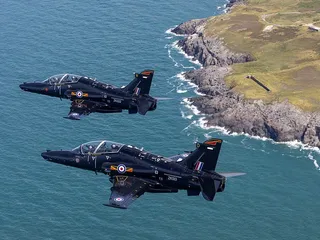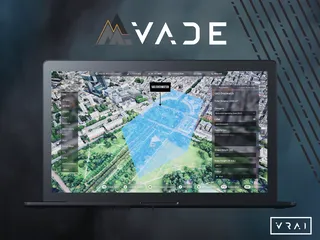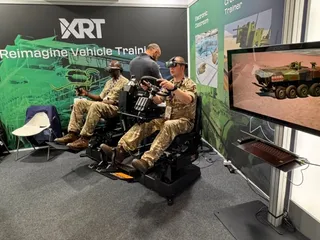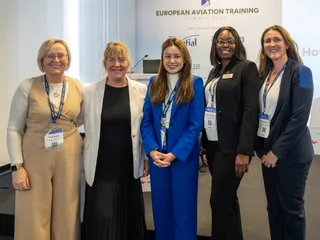Royal Air Force Hawk Replacement
Contact Our Team
For more information about how Halldale can add value to your marketing and promotional campaigns or to discuss event exhibitor and sponsorship opportunities, contact our team to find out more
The Americas -
holly.foster@halldale.com
Rest of World -
jeremy@halldale.com

In recent weeks, there have been several references in the media to the replacement of the RAF’s Hawk aircraft. MS&T’s Dim Jones reviews the state of play and the options.
Two of the gentlemen quoted in these reports are the then Chief of the Air Staff (now Chief of Defence Staff), Air Chief Marshal Sir Rich Knighton, and the Prime Minister, Sir Keir Starmer. The former is reported as saying that: "We don't get what we need from Hawk [T2] today - we get about half of what we should get out of it.", and that: "Speaking quite frankly, I would like to replace the Hawk T2 as soon as we can, to deliver a more modern, more reliable, greater capacity." During a recent visit to RAF Valley, the home of RAF fast-jet (FJ) pilot training, the PM, whose grasp of the subject may be less than encyclopaedic – and, to be fair, he has had more pressing matters occupying his mind - is reported as saying of the Hawk: “I do think it’s right that we upgrade them – and that’s what we’re doing.” Note that “upgrade” does not necessarily mean replace; however, replacement was endorsed by the recent Strategic Defence Review (SDR), which stated that “Hawk T1 and Hawk T2 should be replaced with a cost-effective fast-jet trainer”.
Distinct T1 and T2 Hawk Types
In order to understand the issues at play here, those not familiar with the Hawk need to be aware that the two types are quite distinct: the T1 came into service to replace the Gnat in the RAF in 1976, and the T2 (the domestic version of the 128 series), entered service to replace the T1 as the RAF’s Advanced Jet Trainer (AJT) from 2012. The T1 subsequently continued to equip No 100 Squadron in the Aggressor/FJ WSO Trainer/FAC Support roles, the Royal Navy’s 736 NAS in the fleet support role, and the RAF Aerobatic Team (RAFAT), the Red Arrows. The Red Arrows are now the only users, and the aircraft Out-of-Service Date (OSD) has been extended to 2030.
The two types look fairly alike and, indeed, from the rear cockpit bulkhead back, they have much in common and share a pretty similar performance envelope. In capability, and particularly in avionics, however, they are chalk and cheese. The T1 has an analogue cockpit full of steam-driven instruments and no advanced avionic systems whatsoever, the only sop to the passing years being a stand-alone GPS – a source of welcome guidance when trying to locate Buckingham Palace in dirty weather and on time. The T2 cockpit is fully glass and digital with a comprehensive suite of emulated sensors, and the potential to integrate emerging technologies; a resumé of its capabilities can be found at A Contender with Hawk T2 | Halldale Group.
The two types would also be replaced for entirely different reasons: the T1 because it will be worn out by 2030, and the T2 because it is not doing the job for which it was procured. There is, therefore, a degree of urgency about T1 (although the T-38 has shown what can be achieved in terms of extended longevity, when needs must). The timeline imperative is absent in T2 (notional OSD of 2040), but the pressing matter is a deficit in training achievement. T2’s problem is availability - mostly the result of issues with its Adour engine - rather than capability. It is worth noting that the RAF bought 176 T1s, albeit to service a Cold War front line and other minor capabilities, but only 28 T2s. One hundred thirty Tucano basic trainers were replaced by 10 T-6 Texans, later increased to 14. The impact on output and resilience is self-evident.
It is also worth noting that, whereas in 1974 the capability criteria for a Gnat replacement for the AJT and RAFAT did not differ much, the same is not true today. The desired performance envelope may be fairly similar, but the systems most certainly are not. While reliability and availability are critical requirements for both roles, RAFAT needs a manoeuvrable platform with relatively simple avionic systems, whereas AJT needs much more, and this diversity feeds through to the cost and affordability equation – why pay for expensive systems you are not going to use? The domestic and international reputational benefits which the Red Arrows have generated over the years have been judged to be well worth the modest cost but – certainly from as long ago as the early 90s, when I inhabited a cubbyhole on the 4th floor of MoD Main Building – the affordability of the team was a perennial savings target, albeit not a very serious one. This brings me to another difference between the two requirements, namely country of origin. The positive
contribution to RAF prestige might be maintained if the Red Arrows platform were not British, but the promotion of the UK aerospace industry certainly would not be. In that regard, the impact of a non-British AJT would arguably be much less.
Possible Two-Type Solution
So, notwithstanding the wording of the SDR, a two-type solution becomes a distinct possibility. In the case of AJT, my views are coloured by many years of covering the process of replacing the USAF’s T-38, known as the T-X Program. The very first words I wrote for MS&T, in Issue 1 of 2010, were on this subject; suffice to say that, 15 years on, the winner of that competition – the Boeing/Saab T-7A Red Hawk – is still not in USAF service, with IOC expected in 2027, and the T-38 soldiering on. Developmental issues with a “clean-sheet” solution were always to be expected, and many observers were of the somewhat cynical opinion that the T-X process was deliberately slowed down in order to allow what became the T-7A to compete with its already-in-service rivals. Timelines, however, bring into focus the OSDs of Hawk T1 and T2, the former relatively imminent for reasons of platform life, and the latter allowing less urgency.
Dealing first with AJT, several of the possible contenders were also involved in T-X: the T-7A itself, although programme delays in the US may have a knock-on effect on export availability; the Italian Alenia-Aermacchi M-346; and the South Korean KAI T-50 Golden Eagle. Hawk T2 was an early drop-out due to its ageing airframe technology, as was the Northrop-Grumman offering for different reasons, and the Textron Scorpion never featured seriously at all. To these, we could now add the Turkish Aerospace Industries (TAI) Hürjet, and the UK’s Aeralis, both still in development; more on Aeralis later. I can find no evidence that BAE Systems are contemplating re-entering the AJT arena with a new design. During T-X, Leonardo and Lockheed Martin/KAI were kind enough to give me access to M-346 and T-50A, which I covered at MST Magazine : MS&T 1 2016 and MST Magazine : MST 1/2017 respectively. Boeing were not so forthcoming although, in fairness, the T-7A programme was nowhere near as mature as the others.
I will not rehearse the T-X requirements, save to say that the USAF wanted a supersonic capability, which would have been provided by the T-7A and the T-50A, but not by the M-346 or the Hawk T2. There is no indication that the RAF would require this in a T2 replacement, and the enablers, such as an afterburning engine, do add to the cost. The M-346 alone of the contenders is twin-engined, which again would add to the operating costs, but arguably enhance safety. M-346 is in service with the air forces of Italy, Singapore, Israel, Poland and others, T-50A and its light attack variants with the Republic of Korea Air Force (RoKAF), Iraq, Thailand and Indonesia, The Philippines and Poland. Hürjet first flew in 2023, and is due to enter service with the Turkish Air Force next year. TAI have also signed an MOU with Spain to equip the Spanish Air Force.
Continuing RAF Pilot Training Tribulations
I wrote about the long-standing tribulations of the RAF’s pilot training system in 2022 (RAF Pilot Pipeline Not Keeping Pace | Halldale Group), and clearly things have not improved much. We are told that recruitment of suitable pilot candidates is not an issue, but it appears that retention still is, and the high operational tempo of an increasingly stretched front line will not be helping, future air policing in Ukraine being yet another potential commitment. Today’s front line comprises 137 Typhoon (including the Operational Conversion Unit (OCU)) and 37 F-35; this is a far cry from the Cold War orbat. It is just as well that the slow build-up of the F-35 force (37 of 48 contracted F-35B aircraft received, plus the recently-announced 12 F-35A) has reduced the demand for pilots; the recent National Audit Office (NAO) report on availability of the F-35 force also makes for depressing reading. However, even with such a reduced requirement, the current turnover of pilots necessitates a training output which is clearly not being met.
It is worth noting that, when UK military flying training was contracted out to Ascent Flight Training through the UK Military Flying Training System (MFTS) in 2008, the Hawk T2 was mandated by the government as the AJT, whereas the other trainer types were selected by the contractor. As far as I am aware, there is no suggestion that this was a poor decision, or that the T2 does not provide the required capability, simply that it is not sufficiently available to meet the training task. This is reflected in the fact that, in addition to that undertaken at RAF Valley, RAF and RN advanced flying training has been outsourced to the US (through the Euro-NATO Joint Jet Pilot Training (ENJJPT) Program at Sheppard AFB), to 11 Sqn Qatari Emiri Air Force (a joint training unit at RAF Leeming), and to the International Flight Training School at Decimomannu, Sardinia. Decimomannu is also one of the selected campuses for the UK-led NATO Flight Training Europe (NFTE) programme, and IFTS operates the M-346.
Returning to RAFAT replacement and cost-effective solutions, I recently wrote (Idea to Reality? Aeralis at Stage 3 | Halldale Group) about the emergence of Aeralis, a UK start-up offering a modular approach to providing a suite of configurations and capabilities, based on a Common Core Fuselage (CCF) and interchangeable wings, engine pods (single or twin), cockpits (single-seat or dual), avionics and weapons/sensors. The AJT variant is the benchmark, and it is easy to see how a simple version of this could fulfil the RAFAT requirement, while an avionically advanced model could meet the AJT needs. The company estimates that, if a commitment were made this year, deliveries could start in 2030.
Economies of scale would suggest that the small number of airframes to meet only the RAFAT requirement might be problematic, but AJT and exports could change that picture; the Patrouille de France will soon need to retire their ageing AlphaJets, and there is no French-built aircraft on the horizon; accordingly, the company have already formed Aeralis France. NFTE is another potential target. Aeralis have entered into MOUs with a raft of established aerospace companies and, although the aircraft is still very much “on paper,” a production facility has already been earmarked at Prestwick, Scotland, and development will be accelerated by the use of digital twinning and other technological advances.
Successive cost-cutting exercises since the end of the Cold War, starting with Options for Change while UK forces were still engaged in Gulf War 1, have entirely eliminated any resilience, let alone surge capacity, in the RAF, and this is just as true for the training system as for the front line and, indeed, the other Services. It remains to be seen to what extent compliance with the latest NATO commitment to increased core defence spending will remedy this, but it is to be hoped that some lessons have been learned along the way.
The UK MoD is reported to have ‘launched a competition’ to replace the Hawk, but thus far I have seen no formal timeline. Rapid procurement process has not been a recent hallmark of MoD performance but, for Hawk T1 particularly, speed is of the essence. Tempus, as they say, fugit.


